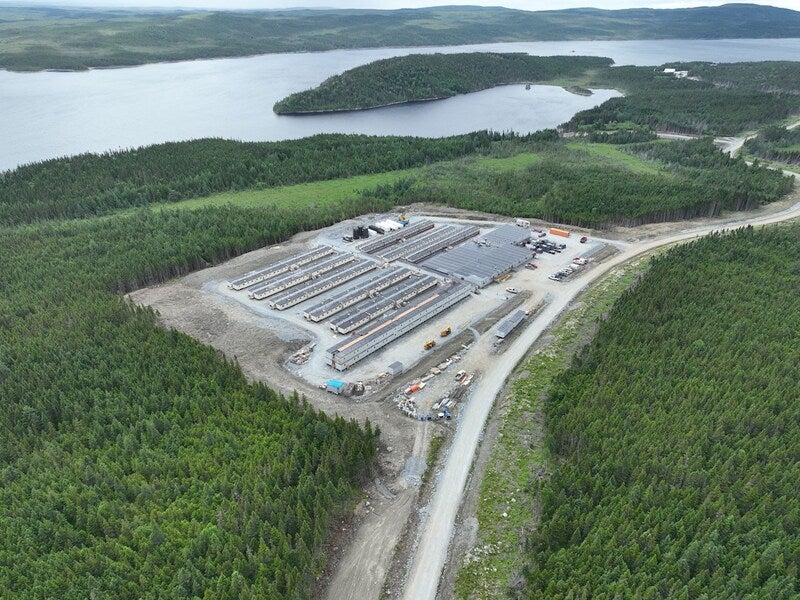Valentine Gold is an under-construction gold project located in the Central Region of Newfoundland and Labrador, Canada.
The project is the principal asset of Canada-based gold exploration and development company Marathon Gold, which fully acquired the Valentine Lake property in July 2012.
Valentine Gold hosts five gold deposits, namely Leprechaun, Sprite, Berry, Marathon and Victory, and several other early-stage gold prospects.
Early works at the mine commenced in October 2022.
In December 2022, Marathon announced the results of an updated feasibility study for the gold project.
The study offered a three-pit mine plan covering Marathon, Leprechaun and Berry deposits leveraging conventional open pit mining and milling strategy.
Valentine Gold Project is scheduled to achieve mill commissioning in Q4 2024 and the first gold production in the first quarter of 2025.
Valentine Gold Project Location
The Valentine Lake property is located in the west-central region of the island of Newfoundland, Canada.
The property consists of 14 contiguous mineral licenses across a landholding of 240km2 or 24,000 hectares.
The gold project’s deposits are situated within a 32km long northeast-trending zone called as Valentine gold project.
Geology and Mineralisation
The property is situated within the Exploits Subzone of the Dunnage tectonostratigraphic zone of Central Newfoundland.
The gold deposits are hosted primarily by the Neoproterozoic Valentine Lake Intrusive Complex, near the contact between the Victoria Lake Supergroup to the northwest and the Silurian (or younger) Rogerson Lake Conglomerate to the southeast.
The Valentine Lake Intrusive Complex features an elongate northeast-trending body of igneous rocks comprising mainly fine- to medium-grained trondhjemite and quartz-eye porphyry units with lesser aphanitic quartz porphyry, gabbro, and minor pyroxenite units.
Gold mineralisation at the property occurs as structurally controlled, orogenic gold deposits primarily consisting of en-echelon stacked dipping extensional vein sets and lesser shear parallel vein sets proximal to the Valentine Lake Zone.
Valentine Gold Reserves
The Updated Feasibility Study announced in December 2022 indicates a three-pit-mine plan delivering 195,000 oz gold (Au) per annum for the first 12 years of a 14.3-year mine life.
The Total Proven and Probable mineral reserves at the project are estimated at 51.6 million tonnes (Mt) grading 1.62g/t Au.
Valentine Gold is regarded as the largest undeveloped gold resource in Atlantic Canada with measured and indicated mineral resources of 3.96 Moz (64.62 Mt at 1.90 g/t Au) and inferred resources of 1.10 Moz (20.75 Mt at 1.65 g/t Au).
Mining and Ore Processing
Valentine Gold will employ conventional open pit methods for mining operations considering the project location and site requirements.
The project mining fleet will include different diesel-powered drills to enable bulk production drilling; selective drilling; and bench-scale grade control drilling. The fleet will also include hydraulic excavators, loaders, hauling trucks and other ancillary equipment.
Ore will be hauled to a crusher and fed to the process plant, while waste rock will be deposited into waste rock storage facilities (WRSF) directly adjacent to the three pits.
The Marathon, Leprechaun and Berry pits will be developed in three phases including an initial phase followed by two pushbacks.
The processing facility will be constructed in two phases.
In Phase I, the capacity of the processing facility will be 2.5 million tonnes per annum (Mtpa). The processing plant capacity will be expanded to 4Mtpa in Phase II.
The first phase will include a semi-autogenous grinding (SAG) mill, ball mill, gravity concentration, gravity tails leaching, carbon elution, and gold recovery.
Phase II will continue to leverage Phase I equipment along with pebble crushing, gravity tails flotation, flotation concentrate regrinding, flotation concentrate leaching, and thickening of both the flotation concentrate and flotation tailings streams.
Infrastructure and Accessibility
The gold project can be accessed by a 63km gravel road from the Town of Millertown, which is connected to the TransCanada Highway and the Buchans Highway.
Electricity distribution company Newfoundland and Labrador Hydro will supply the power required for the project operations, as per Power Supply Agreement with Marathon Gold.
The Star Lake Terminal Station located approximately 20km to the northwest of the Valentine project is selected as the supply point.
Contractors Involved
Several consultants were associated in the preparation of the Updated Feasibility Study for the Valentine Gold Project published in 2022.
This includes Ausenco, APEX Geoscience, John T. Boyd Company, Moose Mountain Technical Services, Stantec Consulting, Golder Associates, GEMTEC Consulting Engineers and Scientists, Vieng Consulting and J.R. Goode and Associates.
In October 2023, Marathon Gold contracted ABB to design and commission the process and power control system for its Valentine Project.
ABB’s scope of work includes the design, supply and commissioning of the mine’s process and power control system.





